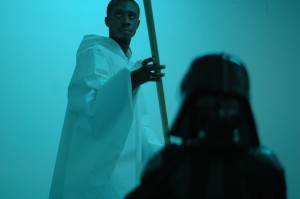 On the day of Halloween, we took our kids to MOVE! at MoMA PS1, a weekend-long series of performances that brought together two things that don’t occupy a lot of my (limited) brainspace: high art and high fashion.
On the day of Halloween, we took our kids to MOVE! at MoMA PS1, a weekend-long series of performances that brought together two things that don’t occupy a lot of my (limited) brainspace: high art and high fashion.
I would like to say that we did this because we are the kind of New York parents for whom each day presents a new urban adventure, that we constantly feed our children a rich diet of the Marrow of Life, that we are forever moving between art exhibits and volunteer opportunities and cultural festivals.
But that’s not really how it goes down. We would have just as likely plopped the kids in front of some cartoons and spent the morning in a half-doldrum waiting for massive sugar attack of Halloween night to come, if it weren’t for the fact that we know and love Brody Condon, one of the artists who was presenting at PS1. And I can’t even claim some distinction from knowing Brody, an esteemed artist. It just so happens that he grew up, as I did, in Key West in the ’80s, so our connection is social and not even intellectual.
But however it worked out, my wife and I did go to PS1 (with my visiting mother-in-law!), and we did take our children with us, and it was amazing. There were Terence Koh’s spacemen, Marc Jacobs’s faux runway, Cynthia Rowley’s paint-smeared models, a fake-blood-and-glitter salon called Dance/Die! that was campy and fun, and, above all, Brody’s project. I really can’t do it justice in words, but it featured robed performers (costumes by Rodarte) with identical long staffs that they needed to keep in constant contact with each other as they circled slowly around the performance space. As with a lot of Brody’s work that I’ve seen, there was something both druid and digital about it—the long staffs functioned as a sort of pixelated electrical circuit that needed to touch for the energy to flow.
The best part, though, was Brody’s unexpected excitement at having my kids, in their full Darth-and-Yoda Halloween getups, invade the performance. For those who don’t know MoMA PS1, it is not a child-centric space. It is, on the contrary, a haven for hipsters and thinkers and others looking for the kind of ethereal experiences that children, with their boorish whining, innate consumerism, and scatalogical imperatives, tend to obliterate.
Brody has no children, but he’s got the good kind of childmind that a lot of artists seem to share. He loved the chaos and contradictions of the kids giggling and chasing each other through his hushed performance. If he—or really, any of the other incredibly friendly artists and visitors—was offended by the banality of kids dressed as Star Wars characters (albeit in homemade or modified costumes that my wife put together that were pretty stunning), there was no sign of it. He actually wanted me to take pictures of Darth (as played by Dalia) and Yoda (worn by Nico). One of my favorite pictures is above—Dalia caught in the foreground, one of Brody’s performers in the background.
I am, as a parent, easily intimidated by museums, galleries, and other adult spaces (even the grocery store) and have a habit of trying to bash my children into behaving like adults in those places. Brody was basically saying, let them do their kidstuff and see how it works in the space. It’s all an experiment anyhow.
And though I may not be the arrogant bastard Matt is, I did allow myself some prideful thoughts at how much my kids took to the whole experience. They weren’t whining for chocolate milk, they didn’t ask when they could go home to watch videos. They were totally captivated. Imagine that: excited by art.
And then, headed down Queens Boulevard on the way home, Nico got excited in a similar way. “Frog, frog,” he shouted, laughing. It took a second before we saw what he was looking at: a gigantic poster on the 7 Train overpass of the Geico gecko, a character that has become beloved to our boy, that he always greets with excitement and the exclamation “Frog!”
I had a momentary ugh-thought, about how we had allowed a CGI pitchman for an insurance conglomerate to colonize my son’s imagination. But then, I tried to channel Brody. Let them do their kidstuff, reserve judgment, marvel at how it all happens. It’s all an experiment anyhow.



